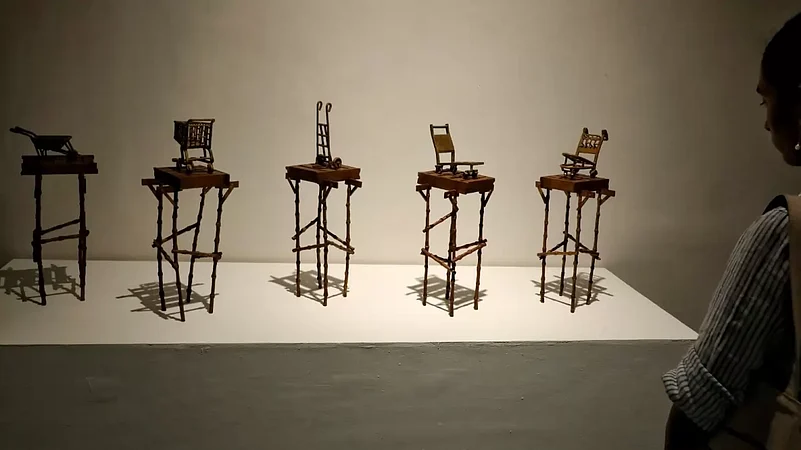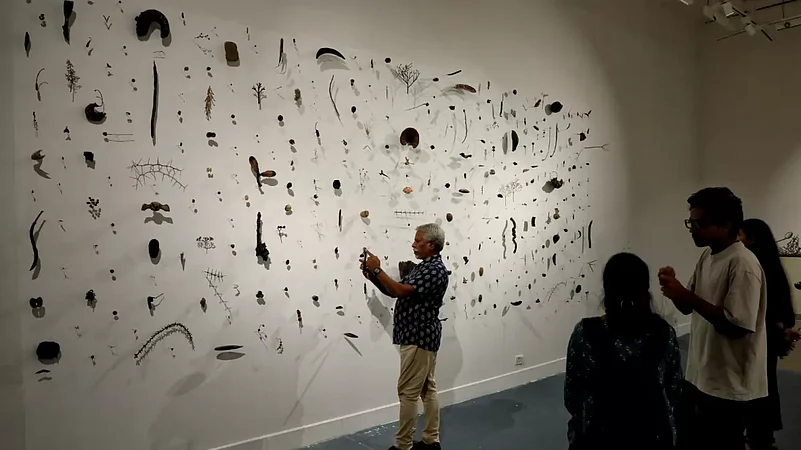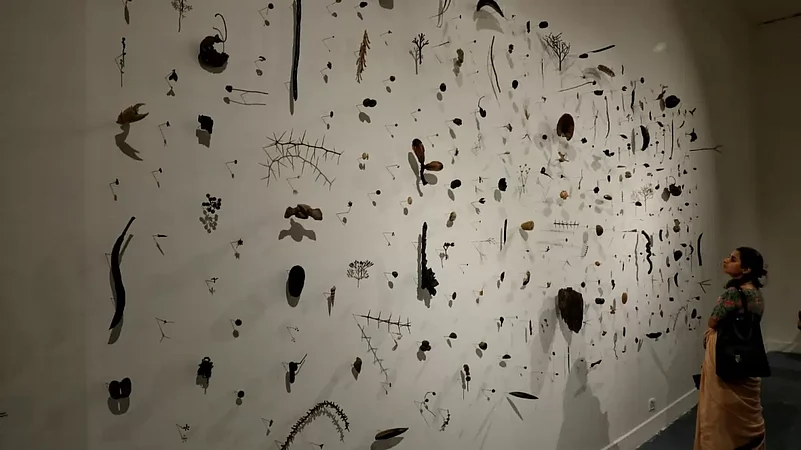Nostalgia is the yearning for a past that was. But what about the past that could have been? Does one yearn to go back to a place that they have never been to before?
An Archive Of Objects From A Vanishing World
Have we made a Faustian pact with technology? Will humanity pay the price for eternal knowledge-on-the-go with eternal amnesia? A recent art show curated by Premjish Achari unscrambles lines that divide the real and imagined, past and present.

A recent exhibition called ‘Things Are Vanishing Before Us’ brought glimpses of such a world that wasn’t. Curated by writer and art critic Premjish Achari, the group show breached the invisible fourth wall of modern existence in the digital age where virtual is real and memories are ephemeral, in a bid to establish roots to a past and distinguish memories from imagination.?
Featuring works by the veritable ‘who’s who’ of the Indian art world, the survey exhibition that took place in Delhi’s Bikaner House last month brought together 80 distinguished artworks from diverse styles and genres within the canon of object-based sculptural practice. While appearing disparate, Achari managed to string the installations into a live tapestry unfolding in layers to evoke a sense of calculated nostalgia for a past we are fast forgetting.

Carefully sidestepping the “nostalgia” trope, which harkens to a glorious or pleasant past, albeit imagined, ‘Things Are Vanishing Before Us’ isn’t a celebration of the past. Rather, it is about reconstruction on the basis of the past. Achari, who currently teaches art history at Shiv Nadar University, juxtaposes the subjective and objective realities of objects and their functions in an increasingly virtual, post-truth world.
“The show is a contemplation on the Faustian bargain we have made with the digital realm. We are drawn to its convenience and accessibility, but at what cost? Are we forsaking the sensory richness of physical objects by letting go of our deep-seated attachment to them?” Achari asked. “It is a call to critically examine our relationship with technology, recognizing the carefully designed algorithms that govern almost every aspect of our day-to-day lives”. He does so by looking at objects that exist as evidence in the physical realm as an antithetical reminder of history in a world that is becoming increasingly virtual.?
A proponent of theoretically and politically informed art curations, Achari is the founder of a platform called Future Collaborations, which aims to highlight curatorial practices, especially in a technologically changing world. The artist’s curatorial vision nevertheless goes beyond digital existentialism and reveals his focus on diversity, making the show a deeper social and political commentary on past and present. Revival of the past has been a key plank of right-wing or majoritarian political narratives across the world that use arguments of civilisation glory and assertions of an imaginary past. Through the show, Achari tries to “break away from the surface-level, imitation-saturated nostalgia that postmodernism is often identified with” in order to allow a deeper and more critical connection with the past. “Especially at a time when imagined pasts are resurfacing to justify the political goals of the politically dominant,” Achari added.

Caste was a visible narrative that many of the pieces examined through cultural artefacts from marginalised communities and their sharp absence from mainstream accounts of heritage.?
Anti-caste artist Prabhakar Kamble's “Mapdand”, for instance, showcases the materials used by the informally organised working class in making cages and items from tin and reused metal sheets because of their affordability. The work mediates of how and why artisans prioritise usefulness over aesthetics for precision but also works as a device to comment on the measured distances enforced in the caste structure.
Mayuri Chari's “Everything Belongs to Me” is a personal memoir that reveals the battles and fortitude of her community, historically marginalised due to caste. Her work elevates the hitherto unheard voices of women from marginalised communities by weaving together heirlooms passed down for generations, as well as asserting these objects' rightful place in national records in a sharp critique to Brahmanical patriarchy.

The interplay of objects with working-class identity was brought out in installations like Suneesh SS's “Wooden Album” uses carpenters’ tools as a motif to provide a glimpse the cultural, working-class milieu of Kerala while another Kerala-based artist Abdulla PA’s ‘Chuttum’ brought together a gamut of disparate objects he had collected in a five-kilometre radius of his Thrissur home mounted on a wall to emphasise the interplay between object and identity with clever use of not just the objects but also the shadows they cast.?
Works by artists, like Madhvi Subrahmanian's “Fertility Jars" and Muskaan Singh's "Kothi”, were commentaries on the evolution of objects of common use through time and how they adapt to changing cultural practices and traditions. Pieces like "This is not my kitchen" by Vinima Gulati, "My Room" by Purvi Sharma and "Withering Away" by Payal Rajput further explored the heavily gendered nature of objects, particularly within domestic settings.?
The idea was to bring out the complex dynamics embedded within everyday objects and their persistent role in shaping reality.?
Addressing the issue of climate change, the exhibition featured pieces such as "Vertical Eye-Land" by Pinaki Mohanty and Sudipta Das' collection of paper sculptures. Pinaki Mohanty’s “Vertical Eye-Land" relived memories of Chilika Lake's vulnerable community, while Sudipta Das’s paper sculptures highlighted the plight of climate-vulnerable communities in Silchar and their abandoned possessions. To Achari, these works convey the “urgency to address our interaction with objects and memories amid climate change” and the “emotional toll of letting go”.?
Achari is part of a section of artists who have been looking at objects as a way to connect past and present, especially at a time when political polarisation has started to morph memory. His curation is reminiscent of Sudarshan Shetty’s 2019 solo showcase ‘Pieces Earth Left Behind' which unveiled 99 objects of everyday life. In fact, Shetty’s installation depicting a wooden video camera was also part of Achari’s curation.?
Through the exhibition, Achari asks crucial questions: “Are we simply adjusting to the new normal or are we caving into its ever-compressing presence? As we navigate the boundaries between reality and hyperreality, can we look beyond technological determinism to recognize if this tradeoff is worth it?” Through a combination of object-based sculptures, the artist hopes to encourage audiences to contemplate the “convergence of the physical with its virtual counterpart” and “critically assess where they stand along this continuum”.

























